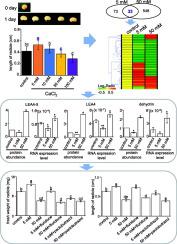Journal of Proteomics ( IF 3.3 ) Pub Date : 2020-10-03 , DOI: 10.1016/j.jprot.2020.103999 Xin Wang 1 , Han Hu 1 , Fang Li 1 , Bingxian Yang 2 , Setsuko Komatsu 3 , Shunli Zhou 1

|
To reveal calcium-mediated germination in soybean, a gel-free/label-free proteomics was performed in radicle of seed imbibed with CaCl2. Morphological analysis presented promoting and suppressing performance of seed growth under 5 and 50 mM CaCl2, respectively. A total of 106 and 581 proteins were identified in response to 5 and 50 mM CaCl2, respectively. Among 33 proteins, which were simultaneously affected by 5 and 50 mM CaCl2 imbibition, proteins related to protein metabolism, cell, development, and stress showed reversed abundance in response to CaCl2 on dose-dependent manner. Notably, protein abundance of late embryogenesis abundant (LEA) 4–5, LEA4, and dehydrin decreased and increased by 5 and 50 mM CaCl2, respectively, consistent with the transcript level. Moreover, inhibited biosynthesis of gibberellic acid repressed growth of 5 mM CaCl2-imbibed soybean, while inhibition of abscisic acid biosynthesis released the suppressing effects of 50 mM CaCl2. Taken together, these results suggest that decreased or increased protein abundance of LEA4–5, LEA4, and dehydrin might determine promoting or suppressing effects of low or high level of calcium on soybean through enhancing seed sensitivity to gibberellic acid or abscisic acid during radicle protrusion.
Significance
Calcium serves as a versatile signal in plant growth; however, calcium-mediated germination on dose-dependent manner remains elusive. In this study, dual effects of calcium on radicle protrusion in soybean were investigated using proteomic approach. Radicle growth of germinating seed was improved by 5 mM CaCl2; however, it was retarded by 50 mM CaCl2. Late embryogenesis abundant (LEA) 4–5, LEA4, and dehydrin displayed converse profiles in response to low and high concentrations of CaCl2 at both protein abundance and gene expression level. Inhibited biosynthesis of gibberellic acid (GA) significantly impeded radicle protrusion in presence of low concentration of CaCl2, while inhibiting of abscisic acid (ABA) biosynthesis released suppression induced by high concentration of CaCl2. These findings suggest that LEA proteins are associated with calcium-mediated radicle protrusion on dose-dependent manner, and seed sensitivity to GA and ABA might determine promoting and suppressing effects of calcium on radicle protrusion in soybean.
中文翻译:

定量蛋白质组学揭示了钙对大豆胚根突出的双重影响
为了揭示大豆中钙介导的发芽,在吸收了CaCl 2的种子的胚根中进行了无凝胶/无标记的蛋白质组学研究。形态分析表明,分别在5和50 mM CaCl 2下促进和抑制种子生长。分别鉴定出响应于5和50 mM CaCl 2的总共106和581蛋白。在同时受到5和50 mM CaCl 2吸收影响的33种蛋白质中,与蛋白质代谢,细胞,发育和应激有关的蛋白质响应于CaCl 2而显示出反向的丰度。以剂量依赖的方式。值得注意的是,晚期胚胎发生丰富蛋白(LEA)4-5,LEA4和脱水蛋白的蛋白质丰度分别降低和增加了5和50 mM CaCl 2,与转录水平一致。此外,抑制赤霉素的生物合成抑制了5 mM CaCl 2吸收的大豆的生长,而抑制脱落酸的生物合成释放了50 mM CaCl 2的抑制作用。综上所述,这些结果表明,LEA4-5,LEA4和脱水醇的蛋白质丰度降低或升高可能通过增强胚根突出过程中对赤霉素或脱落酸的种子敏感性来决定低钙或高钙对大豆的促进或抑制作用。
意义
钙是植物生长的通用信号。但是,钙介导的剂量依赖性萌发仍然难以捉摸。在这项研究中,使用蛋白质组学方法研究了钙对大豆胚根突出的双重影响。5 mM CaCl 2促进发芽种子的胚根生长; 然而,它被50mM CaCl 2阻滞。在蛋白质丰度和基因表达水平上,低和高浓度的CaCl 2响应时,晚期胚胎发生丰富(LEA)4-5,LEA4和脱水醇显示相反的特征。在低浓度的CaCl 2存在下,赤霉素(GA)的抑制生物合成显着阻碍了胚根突出。,同时抑制脱落酸(ABA)的生物合成释放了高浓度CaCl 2诱导的抑制作用。这些发现表明,LEA蛋白与钙介导的胚根突起呈剂量依赖关系,种子对GA和ABA的敏感性可能决定钙对大豆胚根突起的促进和抑制作用。


























 京公网安备 11010802027423号
京公网安备 11010802027423号